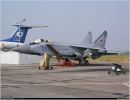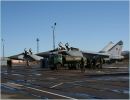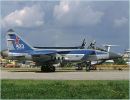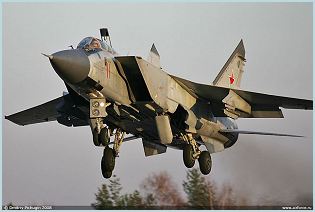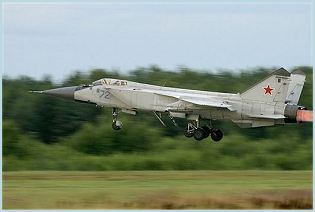MiG-31 Foxhound Mikoyan
| a | ||||||||||||||||||||||
|
Mikoyan MiG-31 Foxhound interceptor fighter aircraft
|
||||||||||||||||||||||
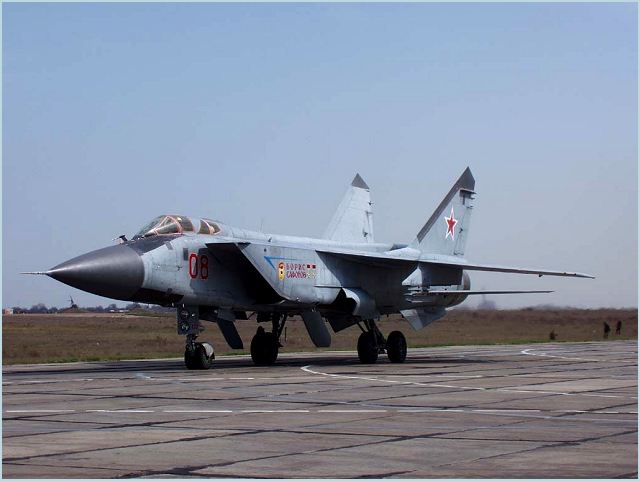 |
||||||||||||||||||||||
|
a
|
||||||||||||||||||||||
|
The Mikoyan MiG-31 (NATO code: Foxhound) is a Russian made supersonic fighter aircraft developed to replace the MiG-25 "Foxbat". The MiG-31 was designed by the Mikoyan design bureau based on the MiG-25. The MiG-31 Foxhound exhibited for the first time at the Paris 1991 Airshow entered production in 1979 and, with a speed of Mach 2.35, now assumes the title of the fastest production military aircraft in the world following the retirement of the Lockheed SR-71. Sitting on its large staggered twin-wheel main undercarriage, the 21.5 m long MiG-31 is a mighty machine. MiG-31 can work efficiently in all weather conditions while fulfilling visual flight rules (VFR) and instrument flight rules (IFR), day and night. It is equipped with state-of-the-art digital avionics. MiG-31 was the first soviet fighter aircraft to have true look-down and shoot-down capability. In 1992 the Chinese reached agreement with the Russian Federation to buy 24 MiG-31 Foxhound long-range interceptors. The MiG-31s were expected to be assembled at a newly set-up factory in Shenyang, with production at a rate of four per month expected by 2000. The last aircraft was to be delivered by the year 2000. According to some reports the agreement included a license to build as many as 700 aircraft, and some projection envisioned that at least 200 would actually be deployed by the year 2010. |
||||||||||||||||||||||
| Main Variants | ||||||||||||||||||||||
|
|
||||||||||||||||||||||
|
|
||||||||||||||||||||||
|
||||||||||||||||||||||
|
|
||||||||||||||||||||||
|
||||||||||||||||||||||
|
|
||||||||||||||||||||||
|
||||||||||||||||||||||
|
|
||||||||||||||||||||||
|
||||||||||||||||||||||
|
|
||||||||||||||||||||||
|
||||||||||||||||||||||
|
|
||||||||||||||||||||||
| Technical Data | ||||||||||||||||||||||
| Design | ||||||||||||||||||||||
|
The MiG-31 Foxhound is a large twin-engine aircraft with side-mounted air intakes, a shoulder-mounted wing with an aspect ratio of 2.94, and twin vertical tailfins. This aircraft is a two-seater with the rear seat occupant controlling the radar. Although cockpit controls are duplicated across cockpits, it is normal for the aircraft to be flown only from the front seat. The MiG-31 has a fully-loaded take-off weight of 41,000 kg and a range of 3,000 km.
|
||||||||||||||||||||||
| Avionic | ||||||||||||||||||||||
|
The MiG-31 was the world's first operational fighter with a passive electronically scanned array radar (PESA), the Zaslon S-800. The heart of the system is the SBI-16 Zaslon radar, codenamed 'Rash Dance' by NATO. This is said to be the world's most powerful fighter radar, with a higher output in kilowatts than any other radar. When a MiG- 31 visited the 1991 Paris air salon, the radome was removed in the static aircraft park (much to everybody's surprise), revealing the radar's fixed, phased array antenna, believed to have been the first such antenna in a fighter. The aircraft's BTsVM(S) mission computer automatically selects the four most threatening targets for engagement. Radar performance is impressive, with a detection range (for a target with 16 m2 cross-section) of 200 km and a tracking range of 120km. The phased array antenna allows the beam to sweep through 120 degrees in azimuth and from 70 degrees above the nose to 60 degrees below. The Russians daim that this allows the MiG- 31 to engage targets spread over a greater area than can its Western equivalent, the F-14, although the Western aircraft call simultaneously engage a greater number of targets Mikoyan daims that the MiG-31 radar is capable of engaging missiles, and have referred to the aircraft as being like a patriot missile which can fly 'repeated missions'. They also daim to be testing the weapons system against 'Stealth' aircraft. The radar also has navigation and situation monitoring functions although navigation is more routinely handled by Marshroot (Soviet equivalent to Omega) and Tropik (Soviet equivalent to LORAN) systems, which give a accuracy of 250 m at a range of 2000 km. The MiG-31 was designed to operate in those areas where there is no ground-based radar coverage, such as the north, using its sophisticated onboard systems for autonomous operations MiG-31s are most often used in group of four (or even eight), linked together by datalink. Operating together, four MiG-31s can cover a strip of territory 900 km. MiG-31 is equipped with RK-RLDN and APD-518 digital secure datalinks. The RK-RLDN datalink is for communication with ground control centers. The APD-518 datalink enables a flight of four MiG-31 to automatically exchange radar-generated data within 200 km (124 mi) from each other. It also enables other aircraft with less sophisticated avionics, such as MiG-25, to be directed to targets spotted by MiG-31.
MiG-31 is equipped with light duty (LD) / speed and direction (SD) sensor, track while scan (TWS) radar, infrared search and track (IRST) system and radar warning receiver (RWR) system. The aircraft assigns partial power to track targets and the remaining to scan. The TWS radar system in the aircraft uses two new technologies – phased array radars and computer memory devices. The IRST sensor detects and tracks jet aircraft and helicopters that emit infrared rays, while the RWR systems detect radar systems emitting radio waves through the ground or in the air. The RWR comprises a visual display unit (VDU) in the cockpit that monitors radars by producing audible sounds. |
||||||||||||||||||||||
| Propulsion | ||||||||||||||||||||||
|
MiG-31 supersonic aircraft is equipped with two Solovyev D-30F6 turbofan shaft engines with a take-off thrust 15,500kgf each. The dry thrust of the D-30F6 is 9,500kgf for each engine. The engine provides a maximum speed of Mach 1.23 at low altitude and increases the aircraft's range. The fuel consumption of the MiG-31 is very high compared to other aircraft, principally due to its multiple roles.
|
||||||||||||||||||||||
| Armament | ||||||||||||||||||||||
|
The MiG-31 has an internal cannon, a six-barrel, 23 mm GSh-6-23 with 800 rounds of ammunition, mounted above the starboard main landing gear bay. The GSh-6-23 has a claimed rate of fire of over 10,000 rounds per minute. The MiG-31's main armament is four R-33 air-to-air missiles (NATO codename AA-9 'Amos') carried under the belly. The R-33 is the Russian equivalent of the U.S. Navy's AIM-54 Phoenix. It can be guided in semi-active radar homing (SARH) mode, or launched in inertial guidance mode with the option of mid-course updates from the launch aircraft and switching to SARH for terminal guidance. A more advanced version of the weapon, the Vympel R-37, which is the replacement for the older R-33, features folding stabilizers to reduce its stored size. Other weapons include the old AA-6 'Acrid', originally deployed on the MiG-25, and the Molniya R-60 or Vympel R-73 short-range IR missiles, carried on wing pylons. Currently the entire MiG-31 fleet is being refitted to carry the newer Vympel R-77 on the wing pylons.
|
||||||||||||||||||||||
| Specifications | ||||||||||||||||||||||
|
||||||||||||||||||||||
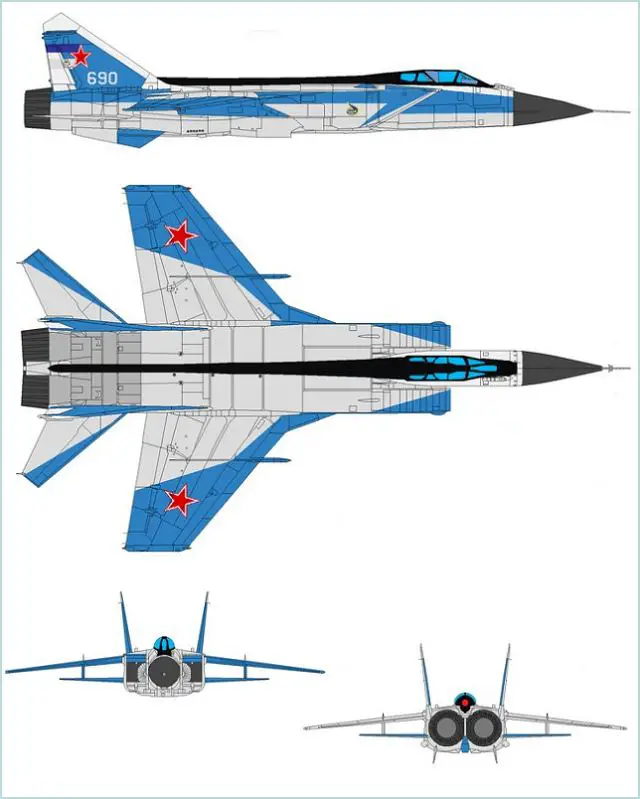 |
||||||||||||||||||||||
|
||||||||||||||||||||||



























